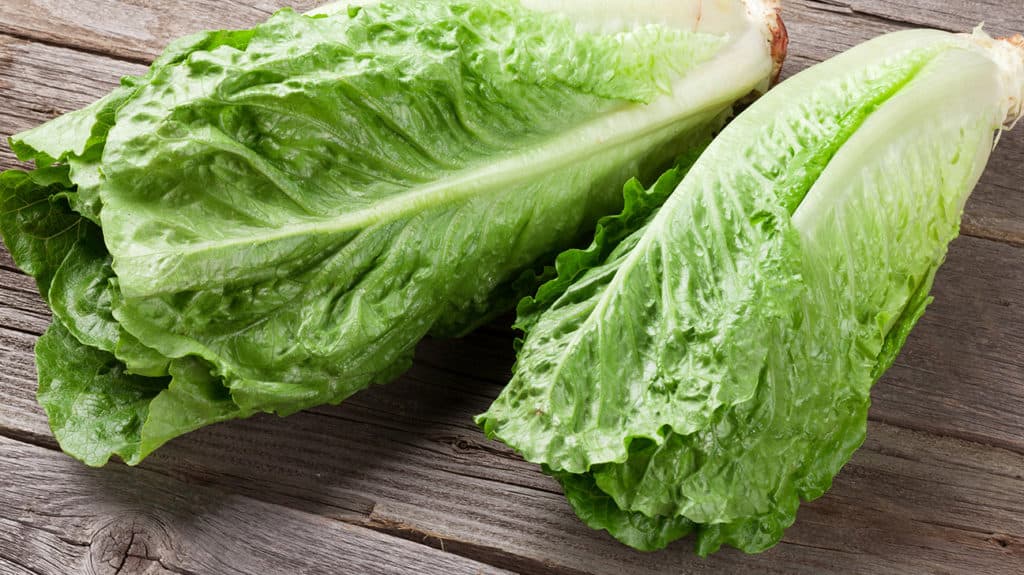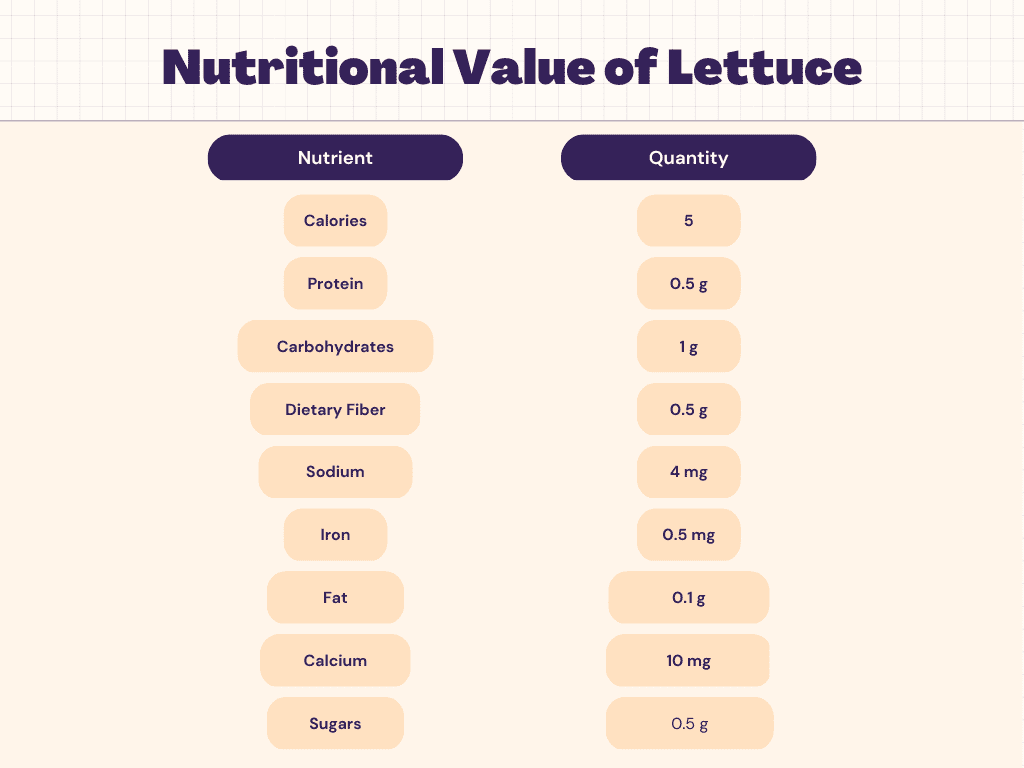Lettuce is a popular and versatile leafy green vegetable that is commonly consumed around the world. It’s a staple ingredient in salads and sandwiches and is often used as a garnish or side dish. While lettuce is often thought of as a low-calorie food with little nutritional value, it actually offers a range of important nutrients that can support overall health and wellness. In this article, we’ll explore the nutritional value of lettuce, including its calorie, protein, and carbohydrate content, as well as the range of vitamins and minerals it provides.
Nutritional Value of Lettuce
Nutritional Facts of Lettuce
Carbs In Lettuce
Lettuce is a low-carbohydrate food, making it a popular choice for those following a low-carb or ketogenic diet. One cup of raw green leaf lettuce contains approximately 1 gram of carbohydrates, with about half a gram of fiber and half a gram of sugar. This low carbohydrate content means that lettuce is unlikely to significantly impact blood sugar levels, and can be a good option for those looking to manage their blood sugar or carbohydrate intake. However, it’s important to note that the carbohydrate content of lettuce can vary based on the specific type of lettuce and how it’s prepared. For example, iceberg lettuce contains slightly more carbohydrates and less fiber than green leaf lettuce.
Protein In Lettuce
Lettuce is not a significant source of protein, with one cup of raw green leaf lettuce containing approximately 0.5 grams of protein. While protein is an essential nutrient for the body, lettuce is not typically consumed for its protein content, but rather for its fiber, vitamins, and minerals. For those looking to increase their protein intake, other plant-based sources such as beans, nuts, and seeds can be good options. That being said, lettuce can still be a healthy addition to a balanced diet, as it provides a range of important nutrients with few calories or carbohydrates.
Health Benefits Of Lettuce
Lettuce provides a range of potential health benefits, including those related to polycystic ovary syndrome (Check our PCOS Plans here), diabetes, thyroid function, and weight loss.
- For example, the high fiber content of lettuce can help to slow the absorption of carbohydrates, which can be beneficial for blood sugar management in individuals with diabetes. Check our Diabetes Plans here.
- Additionally, lettuce is a low-calorie and low-carbohydrate food, making it a good option for those looking to manage their weight. The fiber and water content of lettuce can also help to promote feelings of fullness and prevent overeating. Check our Weight Loss Plans here.
- In terms of thyroid function, lettuce is a good source of iodine, which is essential for thyroid hormone production. Finally, lettuce is a good source of antioxidants, including vitamin C and beta-carotene, which can help to reduce oxidative stress and inflammation in the body. Check our Thyroid Plans here.
While lettuce alone is unlikely to provide a complete solution for these health conditions, it can be a healthy addition to a balanced diet and lifestyle.
Vitamins & Minerals in Lettuce
Lettuce is a good source of a variety of vitamins and minerals, including:
- Vitamin A: One cup of raw green leaf lettuce provides approximately 16% of the recommended daily intake (RDI) of vitamin A, which is important for healthy vision, immune function, and skin health.
- Vitamin C: Lettuce contains small amounts of vitamin C, an antioxidant that is important for immune function, skin health, and wound healing.
- Vitamin K: One cup of raw green leaf lettuce provides approximately 47% of the RDI of vitamin K, which is important for blood clotting and bone health.
- Folate: Lettuce is a good source of folate, a B vitamin that is important for healthy fetal development and red blood cell production.
- Calcium: While lettuce is not a particularly high source of calcium, it does provide small amounts of this mineral, which is important for bone health and muscle function.
- Iron: Lettuce contains small amounts of iron, an important mineral for red blood cell production and oxygen transport in the body.
- Potassium: Lettuce is a good source of potassium, a mineral that is important for healthy blood pressure and muscle function.
- Magnesium: One cup of raw green leaf lettuce provides small amounts of magnesium, a mineral that is important for nerve function, muscle function, and bone health.
It’s worth noting that the nutrient content of lettuce can vary depending on the type of lettuce and how it’s prepared. For example, darker leafy greens like spinach and kale are typically higher in vitamins and minerals than lighter greens like iceberg lettuce. However, lettuce can still be a healthy addition to a balanced diet, especially when paired with a variety of other nutrient-rich foods.
The Bottom Line
Lettuce is a low-calorie and low-carbohydrate food that is rich in fiber, vitamins, and minerals. It is a good source of vitamin A, vitamin C, vitamin K, folate, calcium, iron, potassium, and magnesium. Lettuce provides a range of potential health benefits, including those related to PCOS, diabetes, thyroid function, and weight loss. The fiber and water content of lettuce can help to promote feelings of fullness and prevent overeating, while the high fiber content can help to slow the absorption of carbohydrates, which can be beneficial for blood sugar management in individuals with diabetes. Additionally, the antioxidants in lettuce can help to reduce oxidative stress and inflammation in the body. While lettuce is not a significant source of protein, it can still be a healthy addition to a balanced diet, and its nutrient content can vary depending on the type of lettuce and how it’s prepared.
Faqs
How much Lettuce can I eat in a day?
There’s no specific amount of lettuce that you need to eat per day, as the appropriate serving size can vary depending on factors like your age, sex, weight, and level of physical activity. However, a good rule of thumb is to aim for at least 2-3 cups of leafy greens per day, which can include lettuce as well as other types of greens like spinach, kale, or arugula. In terms of weight, a typical serving of lettuce is about 1-2 cups of raw greens, which provides less than 10 calories and less than 2 grams of carbohydrates. Eating a variety of different types of vegetables, including lettuce, can help to ensure that you’re getting a wide range of nutrients and health benefits in your diet.
Should I eat Lettuce before or after exercise?
There is no specific recommendation for whether you should eat lettuce before or after exercise, as this will depend on your individual needs and preferences. However, lettuce is a low-calorie and low-carbohydrate food that can be a good option for a light pre-or post-workout snack. Eating a small serving of lettuce before exercise can help to provide some energy without weighing you down or causing digestive discomfort while eating lettuce after exercise can help to replenish fluids and nutrients lost during physical activity. That being said, lettuce is not a significant source of protein, which is important for muscle recovery and repair after exercise. Therefore, it’s important to pair your lettuce with other protein-rich foods like nuts, seeds, or lean meats to ensure that you’re getting the nutrients you need to support your active lifestyle.
What are the benefits of Lettuce?
Kale is a highly nutritious vegetable that offers a range of health benefits. Some of the potential benefits of consuming kale include:
- Nutrient-dense: Kale is low in calories but high in nutrients, making it a great choice for those looking to increase their nutrient intake without adding too many calories to their diet.
- Antioxidant-rich: Kale is a rich source of antioxidants, including vitamins C and E, beta-carotene, and various flavonoids. Antioxidants help to protect the body against oxidative stress and may help to reduce the risk of chronic diseases such as cancer and heart disease.
- Anti-inflammatory: Kale contains several anti-inflammatory compounds, including quercetin and kaempferol. These compounds may help to reduce inflammation in the body, which can contribute to the development of chronic diseases.
- Supports heart health: Kale contains a range of nutrients that support heart health, including potassium, fiber, and antioxidants. Consuming kale may help to lower blood pressure, reduce cholesterol levels, and decrease the risk of heart disease.
- May help with weight loss: Kale is low in calories but high in fiber, which can help to keep you feeling full and satisfied. Consuming kale as part of a healthy and balanced diet may help to support weight loss or weight management goals.
- May benefit eye health: Kale is a rich source of lutein and zeaxanthin, two antioxidants that are important for eye health. Consuming kale may help to reduce the risk of age-related eye diseases such as cataracts and macular degeneration.
Overall, kale is a versatile and nutrient-dense vegetable that can be incorporated into a healthy and balanced diet in a variety of ways.
What is the best time to eat Lettuce?
There’s no specific “best” time to eat lettuce, as this will depend on your individual needs and preferences. Lettuce is a versatile food that can be eaten at any time of the day, whether as part of a meal or as a snack. Here are a few examples of when you might choose to eat lettuce:
- As part of a meal: Lettuce can be used as a base for salads, sandwiches, wraps, and other dishes. Adding lettuce to your meals can help to increase your vegetable intake, provide fiber, and add a crunchy texture to your dish.
- As a snack: Lettuce can be eaten raw as a crunchy and low-calorie snack. You can pair it with other vegetables, dips, or dressings for added flavor and nutrition.
- Before bed: Eating a small serving of lettuce before bed may help to promote better sleep, as lettuce contains lactucarium, which has mild sedative properties.
Ultimately, the best time to eat lettuce is whenever it fits into your daily routine and helps you meet your nutritional needs.










